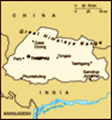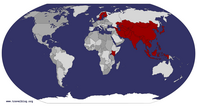Advertisement
Published: December 16th 2006

 Early morning in Trongsa
Early morning in Trongsa
The clouds are slowly starting to give way.My alarm goes off at seven in the morning. Drifting out from sleep my first conscious thought is that I don't want to get up. I think about the joys of a cold shower on the freezing floor tiles and find the concept quite easy to resist. Dorji is still snoring and I ask Tshering what the weather looks like. He pulls the curtain to the side and a gloomy grey light shoots into the room. Marvellous, it still looks like crap. After a bit of moaning I finally get up and take that shower, just as horrible as I had imagined. I can't wait to get out of this place, and if the places further east will be worse than this this trip will turn into a misery.
After breakfast we quickly pack up and prepare to leave. Tshering tells me the hotel offered the crews crap breakfast based on yesterday's leftovers, including cold tea. He and Dorji want to go to Trongsa to get some proper breakfast and I go with them to take another look at the dzong before we leave town. In the car Tshering explains all the guides were very upset with this place, and
that they will definitely not want to come back. Fifteen minutes of driving downhill and we're back in the Trongsa city centre, which really consists of a Y-shaped section of two roads connected by a small circulation place. The guys head into a small Indian style eatery and I climb down to the dzong. Lo and behold, the sun has finally decided to pop out of the clouds and cast some warm rays upon us.
Strengthened by a sufficiently spicy cheese and chilie extravaganza the guys feel a bit better and we begin the trip to Jakar, 68 kilometers away, requiring some 2,5 hours of driving. Now the sun is out in full force and the sky turns to a patchwork of blue and white while we start climbing the mountainside to reach
Yotang La mountain pass at 3 400 meters, the westernmost accesspoint to Bumthang. The pass is draped in prayer flags and the ever present AIDS awareness billboards. from here on it is downhill through a landscape covered in forest, the road winding through sparse villages and farmland. We've arrived in the cultural heartland of Bhutan.
Bumthang is actually made up of four interconnected valleys, Choskhor, Tang,
Ura and Chhume valleys. The Choskhor valley is the largest one and it is also here you will find the dzongs and major temples, and is therefore normally what is referred to when speaking about Bumthang. Many Bhutanese have a special admiration of Bumthang not only because of its religious importance but also because of its "flatland" character, that is, the mountains are spread a little bit more apart to form larger valleys. Unlike in those places were the cities pretty much hug the mountain sides
Jakar town gives a typically flat appearance.
Driving through the roadside villages we see, just like everywhere else in the country, a lot of construction going on. Roads are being widenend, new apartment blocks, guesthouses and even new school buildings. In one of the villages we stop at a typical tourist trap weaving centre to see some weavers in action. We arrive at the Jakar city gates around noon, and immediately head for the hotel. The recently constructed Gongkhar Guesthouse negates all my concerns about another substandard place. The prace is sequaky clean and the staff headed by a man of Nepali descent is very friendly and incredibly polite, and their restaurant really
is something else. After lunch we head downtown to run a few errands. I try to exchange some money at the bank but we're informed that the office is closed at 1 pm, it seems Bhutanese banks are just as useless as everywhere else in the world. We begin our exploration of the Choskhor valley by heading up the hill which overlooks the town and houses the
Yuelay Namgyal dzong. Named after a battle where Tibetans received a smackdown the current structure dates back to the 17th century. It certainly looks as original and decidedly unique as all the other dzongs do. And just like other dzongs, it is a nightmare to try and photograph unless you happen to equip a helicopter. Inside the dzong we stumble on layman dancers practicing their moves for the coming festival. There will be a grand tsechu here in Jakar starting in a few days, and a lot of tourists will be pouring in as well, but we will have moved on east by the time it begins.
There are actually two dzongs in Jakar, the other being
Wangdichholing palace. Originally a royal palace it today serves as housing for a 32 strong
body of monks. It features a central temple tower in a courtyard surrounded by four walls. As we arrive we generate a lot of interest from some of the young monks, taking a break from the chanting which can be heard echoing among the walls. We are also invited inside the dark rooms to look around while the cacophony of twenty different mantras are being chanted all around us.
We leave our young friends and drive back through town and on to the opposite side of the river. We follow a twisting narrow road up the hill which leads to a temple complex, or actually as Tshering explains, a buddhist school, or Shedra. There are a few schools like this in Bhutan, this one is the Lhodrak Kharchhu Shedra, and there is a large number of young monks studying here. Dorji immediately sets out to start spinning the large prayer wheels that flank the entrance ot the courtyard, and their massive gongs start ringing through my body. There is a splendid view of Jakar town from here, and it looks like nothing more than a small settlement. I've read on the wikipedia that the small structures are threatened by
the large river and I don't doubt it. There have been some terrible flash floods in Bhutan, walls of mud and trees being pushed downstream tearing down bridges and flooding houses. Apparently there are plans to relocate the town centre into larger multi story buildings away from the river.
During our visit to the temple at the Shedra we stumble on an offering ritual to a local deity. There is a small chamber next to the main temple hall with an altar dedicated to the local deity, and inside sits a monk chanting while at the same time hammering a drum and two cymbals. Outside we talk a bit with three monks on kitchen detail. They are cutting chilies to go together with a meal of potatoes and spinach. Near the kitchen two men are at work cutting up a cow, working barefoot in puddles of blood. Although buddhist philosophy dictates all life is sacred the more pragmatic line of buddhist practice can see between the fingers for special occasions, even in a place such as a buddhist college.
The sun is already comging down again but we set out for a final visit to another monastery on
the eastern side of the river, Tamshing Lungrub Chholing, the Temple of Good Message, or as it is more commonly known,
Tamshing Goemba. Located a bit farther out of town this is one of the most important places of the Nyingma school of Buddhism in Bhutan. We are lucky to have arrived just in the middle of the closing ceremonies of a local tsechu. A single atsara is entertaining the gathered crowd while three monks slowly work their way through the assembled visitors to offer blessings. The temple is said to have been built by the famous treasure discoverer Pema Lingpa and angelic helpers from heaven, and it can pride itself with having very old unrestored wall paintings thought to have been drawn by Pema Lingpa himself. Born in 1450 he is one of the famous tertons, or treasure discoverers that found long lost religious artifacts hidden by buddhist masters such as Guru Rimpoche. His dances and paintings are also central in the Bhutanese religious heritage.
Inside the temple is a large statue of Guru Rimpoche who is supposed to be looking to the heavens, instead it feels like his spooky gaze stares right through your soul. Apart from
the usual offerings in front of the figure such as seven bowls of water this is the first time I get to study
tormas close up. Symbolizing different offerings, such as food, tormas are essentially painted sculptures made from butter and flour. One of the recurring themes is the one made to look like a skull. Basically it looks like the skull minus its jaw flipped upside down. Optic nerves are sticking out from the eye sockets and run around the skull to end in a pair of eyes resting on top of the cheek bones, staring back at you. The whole figure rests at a triangular (and hence evil) fundament. Take good care of your karma, or this is how you may end up in the afterlife!
As we are about to leave the inner sanctum we learn that a torma offering ceremony is going to take place in the courtyard just outside, and suddenly the room is full with monks collecting other more innocent looking tormas and carry them outside. We go watch the ceremony, in which a small altar has been decorated with tormas, flanked by two lines of senior monks, sporting a number of different
coloured robes. A group of onlookers stand around in their colourful ghos and kiras and since we are now outside this means I am allowed to take pictures. A group of women dance in a circle and perform traditional songs, which is then followed by a long speech by some sort of headman. He thanks everyone for joining the ceremony and regrets to see their dwindling number; each year seems to gather less and less revelers. When his speech is finished the sky is dark and butter lamps burn around the altar as laymen and monks alike make monetary offerings one by one, their bills being sorted in long lines in front of the altar. The evening is getting chilly, the valley floors of the Bumthang region are situated at high altitude. We're freezing quite a bit as we head back to the hotel for dinner.
My room is very cold and I decide to take a hot shower. Well, it turns out to be hot and cold. Just as I step out of the shower the power goes out.
Not again, I lament. I get dressed in the darkness and ironically the light comes back on when I
am done. Over at the restaurant the manager has lit a fire in a stove and had the decency to place me at the table just next to it. The staff are just as attentive and polite as they were at lunch time, and as the buffet opens we are treated to very well cooked food. We get red rice, beef, spinach, cheese momos (dumplings), carrots and an excellent hot daal lentil soup. Back in my cold room I don't bother about the stove and head straight into my cool bed and burrow under the thick blankets.
Advertisement
Tot: 0.121s; Tpl: 0.015s; cc: 14; qc: 24; dbt: 0.0628s; 1; m:domysql w:travelblog (10.17.0.13); sld: 1;
; mem: 1.1mb























